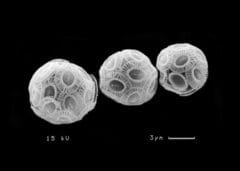
Unique laboratory experiment shows rapid evolutionary adaptation to ocean acidification and warming
The single most important calcifying algae of the world’s oceans is able to simultaneously adapt to rising water temperatures and ocean acidification through evolution. A unique long-term experiment with the species Emiliania huxleyi at GEOMAR Helmholtz Centre for Ocean Research Kiel shows that the evolutionary potential of the algae is much greater than previously thought. In their laboratory evolution experiment, the scientists have shown for the first time that evolutionary adaptations to multiple stress factors do not necessarily interfere with each other. Further work will reveal how evolution in ocean microbes may affect the function of the ocean in removing carbon dioxide to the deep sea and whether or not laboratory findings can be translated into the natural ocean environment.
In an unprecedented evolution experiment scientists from GEOMAR Helmholtz Centre for Ocean Research Kiel and the Thünen Institute of Sea Fisheries have demonstrated for the first time, that the single most important calcifying algae of the world’s oceans, Emiliania huxleyi, can adapt simultaneously to ocean acidification and rising water temperatures. In their study, the researchers found no evidence for the widespread idea that evolutionary adaptations to these two aspects of climate change would interfere with each other.
“Even though the experiment was conducted under laboratory conditions, it clearly shows the high potential for evolutionary adaptation in an oceanic microbe such as Emiliania huxleyi”, Lothar Schlüter, first author and PhD student at GEOMAR, points out. “Now that evidence has been provided, predictions about the future ocean definitely have to take such adaptive changes into account.” The study was funded by the Kiel Cluster of Excellence “The Future Ocean” and the German research network BIOACID (Biological Impacts of Ocean Acidification). The results will be presented in the October issue of the journal Nature Climate Change.
The study was initiated by isolating a single cell of Emiliania huxleyi from the Raunefjord in Norway. Since the algae reproduces by cell division about once per day in the laboratory, numerous genetically identical cultures could be derived from the isolate. Five cultures each were kept under control conditions (15°C) and at elevated water temperature (26°C) in combination with three different concentrations of carbon dioxide (CO2): a control value with today’s conditions, the conditions of the Intergovernmental Panel on Climate Change’s “worst case scenario” and the highest possible degree of acidification.
After one year – corresponding to about 460 algae generations – the scientists tested how the adapted and the control populations reacted to the high temperature within five-day intervals: The adapted populations grew significantly faster than the non-adapted at 26 degrees – regardless of the carbon dioxide level. The adapted cultures produced even more new biomass and about twice as many calcite platelets than the control group under the high temperatures.
The Latest on: Ocean acidification
[google_news title=”” keyword=”Ocean acidification” num_posts=”10″ blurb_length=”0″ show_thumb=”left”]
via Google News
The Latest on: Ocean acidification
- Chef cooks meals with unexpected invasive species: 'There's nothing to really keep their populations in check'on April 27, 2024 at 5:30 pm
The crabs have also been responsible for coastal erosion, excavating parts of marshlands. Chef cooks meals with unexpected invasive species: 'There's nothing to really keep their populations in check' ...
- Indian Ocean basin to see accelerated warming, says studyon April 27, 2024 at 5:20 pm
C per century, leading to severe weather events, marine heatwaves, and extreme cyclones, impacting monsoon development.
- Mussel shells off Connecticut's coast are getting less dense. Here's why scientists are concernedon April 26, 2024 at 5:00 pm
Where they used to be expansive, now they’re just a thin band throughout the most ideal zone.” She said that warming, ocean acidification and changes in local conditions can have multiple, competing ...
- How this Colorado science teacher helps students become environmental changemakerson April 26, 2024 at 8:08 am
Fuentes-Tauber was named 2023 Earth Science Teacher of the Year by the Rocky Mountain Association of Geologists Foundation and was also one of three Colorado science teachers named state finalists in ...
- Museum Program Will Look At Ocean Acidificationon April 25, 2024 at 9:00 pm
The Cape Cod Museum of Natural History in Brewster will present four sessions of “Ocean Commotion” on Saturdays, May 4 and 18, and June 1 and 15, from 10:30 to ...
- International Tribunal Set To Issue Climate Change Opinion On May 21on April 24, 2024 at 11:28 am
The International Tribunal for the Law of the Sea has announced they will deliver their advisory opinion on climate change and international law on May 21.
- From the coast to the deep sea, changing oxygen levels affect marine life in different wayson April 23, 2024 at 10:50 am
Earth's atmosphere maintains a constant level of oxygen, whether it is a wintry, rainy day or hot summer. Across the ocean, oxygen concentrations vary enormously between different places and over time ...
- Elaina’s Experiments: Ocean acidificationon April 22, 2024 at 3:32 pm
On this segment of Elaina’s Experiments observe how water absorbs carbon dioxide causing it to change colors through acidification. Chelsy Lancaster, a STEM Program Specialist with the Kern County ...
- Can this ocean-based carbon plant help save the world? Some scientists are raising red flagson April 21, 2024 at 2:00 am
In Singapore, a new plant will turn CO2 from seawater and air into the same material as seashells, in a process that will also produce “green” hydrogen ...
- Coral reef microbes point to new way to assess ecosystem healthon April 16, 2024 at 5:01 pm
A new study shows that ocean acidification is changing the mix of microbes in coral reef systems, which can be used to assess ecosystem health.
via Bing News










